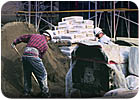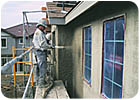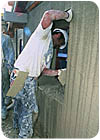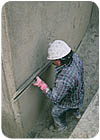
"With normal Portland cement, stucco is a 10-day project," says Jorge Vera, general superintendent for Mid Valley Plastering Inc., of Lathrop, Calif. "With this new cement, stucco is just a three-day project. If I can put 10 days into three, I make money."
"The new cement enables me to apply the scratch and brown coats in a single day, and apply the stucco color coat the very next day so I can move forward without tying up equipment or crews," says Steve Browne, director of operations for Quality Plastering Corp., Sacramento, Calif.
The new cement they are discussing is RapidSet Eisenwall, a premium cement for exterior plaster developed by CTS Cement Manufacturing Corp.
Both contractors are now using Eisenwall on multi-family housing projects built by one of the largest homebuilders in the country.

Company representative for CTS, Conrad Bigelow, explains that with Portland cement plaster, the building codes require a contractor to wait two days after application of the scratch coat (base layer) before applying the brown coat (second layer), and then seven more days before applying the top coat that provides stucco its final color and texture.
"This requires a contractor to return to the same job site at least three times to work on the same piece of wall, ties up scaffolding for almost half a month, and delays the progress of other trades that must wait until plastering is complete," says Bigelow. "The contractor also has to keep Portland cement plaster damp during the first 48 hours after applying both the scratch and brown coats. Even with these steps, conventional stucco can develop shrinkage cracks that detract from a project's appearance and can result in costly call-backs for repair work."
Bigelow, who was a plastering contractor before joining the company, says that instead of using Portland cement, the Eisenwall material contains a special cement that cures completely in a matter of hours. The rapid-setting cement, he points out, has been used for many years for other applications. It is used, for example, to make concrete for highway repairs that have to be open to traffic in just a few hours. Eisenwall, however, is the first product to formulate the cement specifically for plaster and was tested extensively at the University of California-Los Angeles, before being brought to market.
In addition to its strength development, he states that the special formulation of the plaster significantly reduces shrinkage cracking in plaster, resulting in fewer callbacks for repairs. It also produces a stronger, harder plaster that is more resistant to impact damage. The product is approved under an ICC Evaluation Services Report and by the City of Los Angeles.

Plaster proof
One of Browne's first projects with the material, a 276 condominium and townhouse project in Milpitas, Calif., offers a side-by-side comparison of Portland cement and Eisenwall-based plasters."We did the first part of the project with conventional Portland cement and experienced cracking right away," says Browne. "But when we switched to Eisenwall for the rest of the project, we noticed that cracking diminished tremendously. While it's only been four months since we did the work, it looks favorable for us to have fewer call backs since shrinkage cracking usually occurs in the first few months."
Vera echoes these observations about using Eisenwall on a 120-unit townhouse project in Brentwood, Calif.
"Ordinarily, I want to wait a few years to tell if a new product's good or bad," he says. "We started using this plaster five months ago; if it was going to crack, I am pretty sure I would have gotten a call from the customer by now."
The plaster has been available in Southern California for the past decade while RapidSet gained experience with the product and expanded their production capacity.

Learning curve
Both applicators stress that the fast setting of the plaster requires better coordination of the crew to make sure the plaster doesn't harden before it can be applied and finished. With conventional concrete, for example, one can start mixing plaster while the crew is still getting into position on the wall. But with this new plaster, everyone has to be in place and ready to go before mixing begins.Vera says that before, he had to wait over an hour before floating conventional plaster but the new plaster he can start in approximately 20 minutes. Bigelow notes that a retarder is available for use on hot days and when it may be necessary to slow the reaction.
Browne recommends that the crew be more diligent on how much they mix and apply and to ensure they wash out equipment during breaks.
"Instead of my usual eight to 10 person crew, I increase manpower to an 11 or 12 man crew, putting a couple of extra finish guys on the wall to keep up with the quick setting," he says.
He also notes that using this product feels pretty much like working with conventional plaster but that workers can only mix as much as can be finished in a short time. It requires coordination between the applicators spraying it on the wall and the guys coming along behind to screed and float it.

Costs versus value
The material costs a premium compared to ordinary Portland cement. But both applicators and their customers say that, depending on the project, it ends up making them money.Browne states that the premium for the material is offset by indirect savings since equipment gets released sooner and he has to do less customer service since there are fewer call backs. Eisenwall, he says, also makes sense for smaller projects. "We used it on a model home that was on an accelerated schedule. The quicker the developer got the model open to the public, the quicker they could start getting sales."
Both contractors say they have started using the cement on custom homes and small commercial projects to cut "windshield time" driving to and from job sites.
"We use it on smaller projects where applying just one coat would not be a full day of work for a crew," Browne explains. "It allows us to do the first and second coat in the same day so we don't have to come back as often."
The developer for whom they work has run a cost/benefit analysis comparing the cost of materials to the savings in time. Since most of the cost of stucco is due to equipment and labor, not materials, they found that Eisenwall is not dramatically more expensive than conventional stucco. Their superintendent says that it's a small price relative to the total costs of a unit.
If you read this article, please circle number 353.
